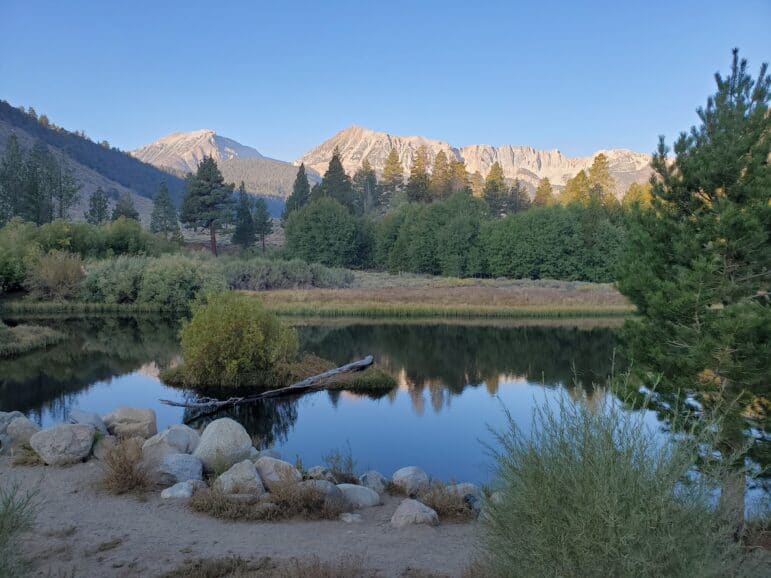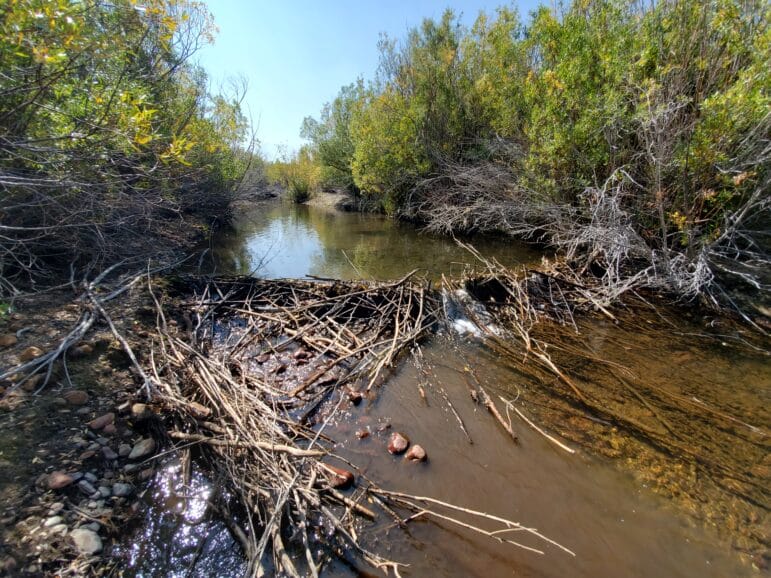
After driving all day, I arrived at the Pumice Palace in Lee Vining just after sunset, and no one was home … in June 1995 … and in September 2021. In 1995, I was starting my summer internship with the Mono Lake Committee. As it got dark and I prepared to move in, I read a note on the door that said the other interns were at a potluck.
It was only nine months after the California State Water Resources Control Board had issued Decision 1631, the water rights order protecting and restoring Mono Lake, its tributary streams, and waterfowl habitat. There was so much excitement—it was one of the wettest years on record, Mono Lake was rising fast, lots of water was flowing down the streams, and the Mono Lake Committee and Los Angeles Department of Water & Power (DWP) were working together to implement the brand-new State Water Board Decision—to raise Mono Lake’s level and restore stream and waterfowl habitat.
In September 2021 it had been two long years since I had been to the Mono Basin, due to the Covid-19 pandemic. I drove through large burned areas from the 2021 wildfires, and once in Mono County I passed many fire scars from recent years that were overgrown with invasive cheatgrass—including in the Mono Basin. There was wildfire smoke obscuring the views of the Mono Basin, and the smoky smell triggered a mild headache. The Sierra Nevada was the least snowy I’d ever seen it, remnant glaciers and icefields were melting away, and Mono Lake was dropping, due to the latest drought combined with climate change.
It was getting dark as I prepared to stay at the Pumice Palace for a couple of days of field trips, and I felt less hopeful than the first time I set foot in the door 26 years ago. The world was full of difficult challenges—among other things, a pandemic, climate change, drought, wildfires, racism, insurrection, oppression, violence. The Mono Basin was now full of bad news too—a dropping lake level, a delayed State Water Board order, spreading invasive species, larger more frequent more intense wildfires, horses damaging springs and vegetation, National Forest closures, and visitor impacts from overuse. Many of these challenges were unexpected 26 years ago. The world had changed, and it was hard to have hope. It felt like nothing was getting better and everything was getting worse.
But we need to have hope. So I started looking for it.
Early the next morning, the smoke had settled and the views I hadn’t seen in two years were back. The Mono Basin still is, and always will be, a spectacularly beautiful place. People need beauty. We need this place, and we need to take care of it, we need to keep things from getting worse, and we need to restore the stability, beauty, and integrity of the biotic community. Our work is more important than ever.
I spent the day looking at the Los Angeles Aqueduct facilities and the streams, with the State Water Board’s long-awaited stream restoration order in mind. A Great Blue Heron at the Walker Creek diversion pond flew away on hopeful wings; Walker Creek and Parker Creek will not be diverted anymore—a ecological triumph. A new Grant Lake Outlet will finally allow Rush Creek to experience a more natural pattern of peak snowmelt runoff, accelerating restoration and maintaining the stream ecosystem that is adapted to those flows.
Upper Rush Creek was beautiful. An angler stood in the stream flyfishing. But dying trees and too few areas with a multi-story cottonwood forest pointed to the urgency of the new phase of the restoration program. At the Rush Creek confluence with Walker Creek, I looked upstream and felt hopeful about the increasing number of cottonwoods visible in that reach.
But the most hopeful thing I saw that day was in the Rush Creek bottomlands, where water was spreading out more than I had ever seen it in September of a dry year. The 2017 extreme-wet-year peak flow had changed everything, and beavers were building numerous dams, creating large ponds, backing up water, flooding new areas and turning them into marsh. Everything we had hoped for back in 1995 was happening—but not in the same places as the named channels identified on 1929 aerial photos, because the world had changed. And that was okay.
Restoration of Rush Creek’s wide multiple-channeled deltaic bottomland has always been challenged by incision—the downcutting caused by the stream reaching the artificially-lowered Mono Lake level—and there were concerns about the higher peak flows in the restoration order making it worse. But the beavers were showing that we needn’t be afraid—they were using the trees we planted in the late 1990s, and the plethora of smaller willows that thrive on Rush Creek, to build many small dams to check the incision. Shifting channels due to floods and beavers meant some areas were drying out, and others were getting flooded, but overall the net effect was positive. The beavers were giving me hope.
Channel 8—the most recently rewatered channel, with flows turned up by the beavers and the 2017 peak flow—was a wildlife paradise. The only duck I saw all day was there, as well as many small fish, and a water shrew. I saw another Great Blue Heron—perhaps the same one I saw that morning.
Channel 10—rewatered in 1995 and planted with willows, cottonwoods, and Jeffrey pines in 1996—had several beaver dams mitigating the incision, a 25-year-old Jeffrey pine falling into the channel to become valuable large woody debris, and a cottonwood forest that provided shade and habitat for birds. At one point I scrambled out of a channel that had more water in it than I had seen in years—this in September of a drought year—and found myself in the cool, grassy shade of a pine we planted 25 years before. Wind blowing through a grove of Jeffreys we planted made sweet-smelling music. I couldn’t contain my enthusiasm—I was crying, laughing, and so proud of our work. Riparian forest restoration is long-term, hopeful work—we plant creatures that live longer than we do—and sometimes it takes a quarter century—or two years away during a pandemic—to really see the changes. I had found the hope I had so desperately been seeking.
The lesson of hope that I felt that day was broader than just the stream restoration program. With 16,000 members, we have the power to protect and restore and educate within the constraints of the changed world. We know what needs to happen, and we can work with partners to make it happen, as the Committee has always done. With reductions in water diversions, Mono Lake will rise faster to the management level. A higher Mono Lake will restore waterfowl habitat, stream habitat, protect air quality, and protect the Mono Lake ecosystem for millions of migratory birds that depend on Mono and other salt lakes. Working with DWP to implement the new restoration order—with the help of beavers—will protect and expand the wildlife paradise along the creeks.
None of these tasks will be easy. Let’s get busy. We can do this. Thank you for your support that allows us to work miracles with water in the desert. And if you need a dose of hope, come and visit the wildlife paradise that is the Mono Basin.
Photos by Greg Reis.


